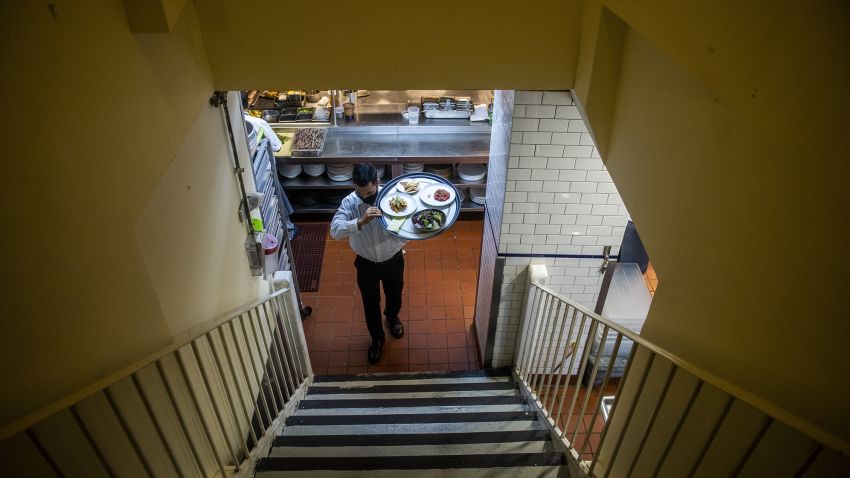President Joe Biden faces a paradox that no recent predecessor has: Booming job growth can signal problems, as well as benefits, for American workers.
The Labor Department’s new employment report makes plain the continuing benefits of the economy’s strong, speedy recovery from the pandemic catastrophe. The economy added 431,000 jobs in March and 95,000 more than previously recognized for January and February. That brought average job gains over the first three months of this year to 562,000.
Wages continued to rise at an annual rate of more than 5%. The unemployment rate dipped once again to 3.6%. Demand for workers has been strong enough, and pandemic threats tempered enough, to lure back many Americans who had earlier dropped out of the labor force.
“Record job creation, record unemployment decline, record wage gains,” Biden declared as he celebrated the data at the White House. “People are making more money, they’re finding better jobs, and – after decades of being mistreated and paid too little – more and more Americans now have real power now to get better wages.”
As Biden’s comments indicated, Friday’s data would have represented dreamy employment data for presidents like Ronald Reagan, Bill Clinton, George W. Bush and Barack Obama. Before coronavirus hit, Donald Trump never approached that level of monthly job gains.
But spiking inflation, which Biden acknowledged, has dramatically altered the context for those gains.
In the four decades since the Federal Reserve squeezed inflation out of the economy in the early 1980s, the threat of dangerously rising prices became a distant memory. When Biden served as vice president under Obama, annual inflation never reached even 3.5%.
Now inflation is running at an annual rate of nearly 8%. The paychecks of American workers are not keeping up despite those rising wages.
Moreover, the fact that employers keep hiring so many workers reflects pressure for inflation to continue. Businesses need more workers as they struggle to meet consumer demand for goods and services.
So long as they can’t keep up, prices will keep rising. And that sours the mood of Americans on the economy and Biden alike.
In part, the President has been victimized by circumstances. The challenge of restarting the economy after disruptive pandemic shutdowns has made it harder for businesses to supply what consumers want to buy. The rate of inflation has risen throughout the developed world.
The challenge has been exacerbated by pandemic-induced changes in the patterns of consumer purchases. The administration’s assiduous efforts to ease supply chain backups at ports and internal transportation hubs can help only at the margins.
Now the war in Ukraine has introduced a new set of inflation pressures, most conspicuously in rising prices for gasoline. White House attempts to label this “Putin’s price hike” don’t ease motorists pain, though the massive release of oil from the Strategic Petroleum Reserve Biden announced this week may temper further increases this year.
At the same time, Biden and Democrats in Congress have themselves contributed to the problem in a way that illustrates the double-edged sword of 2022 economic news.
Even critics acknowledge that the $1.9 trillion American Rescue Plan they pushed through last year accelerated the economic recovery. That has helped generate, and sustain, impressive job gains.
But Biden’s allies also acknowledge that the rescue plan also fueled inflation. Features like its $1,400 relief checks and expanded, refundable child tax credits stimulated the consumer demand that businesses can’t keep up with.
That assistance may have also contributed to inflation-producing labor shortages by allowing some Americans to take their time returning to the work force. Data compiled by the financial firm J.P. Morgan Chase show that average bank balances at the end of 2021 remained slightly above pre-pandemic levels, cushioning the effects of rising prices.
J.P. Morgan’s report said that was especially true for lower-income workers, who have been in particularly short supply as the easing pandemic boosts business at hotels, restaurants and other service providers. But wages for lower-income workers that last year outpaced inflation now appear to be falling behind.
The Federal Reserve has announced more urgent efforts to curb inflation through higher interest rates. That will make it harder to maintain current levels of job growth. So will the simple fact that the economy has nearly restored pandemic-induced job losses, putting employment changes back in more normal, familiar territory.
“My biggest concern is if the pace of hiring slows and the wage gains continue,” said Betsey Stevenson, a former Obama administration economist who now teaches at the University of Michigan. That would signal labor shortages that would extend inflationary pressures.
Before Putin invaded Ukraine, economists generally expected inflation to cool down during 2022. There remains substantial debate over how quickly it will cool down now, and whether the US can avoid a durable, damaging surge without a painful downturn that would throw many recently hired workers out of their jobs.
“I do think it more likely that the bad news on inflation is more transitory than the good news on jobs,” said Justin Wolfers, also a University of Michigan economist. “And if you went back two years ago and offered me the choice of whether to risk somewhat overheating the economy, as we did this time, or undershooting and creating a long, slow, tepid recovery, as we did in 2008, I would have chosen the risk of overheating.”

